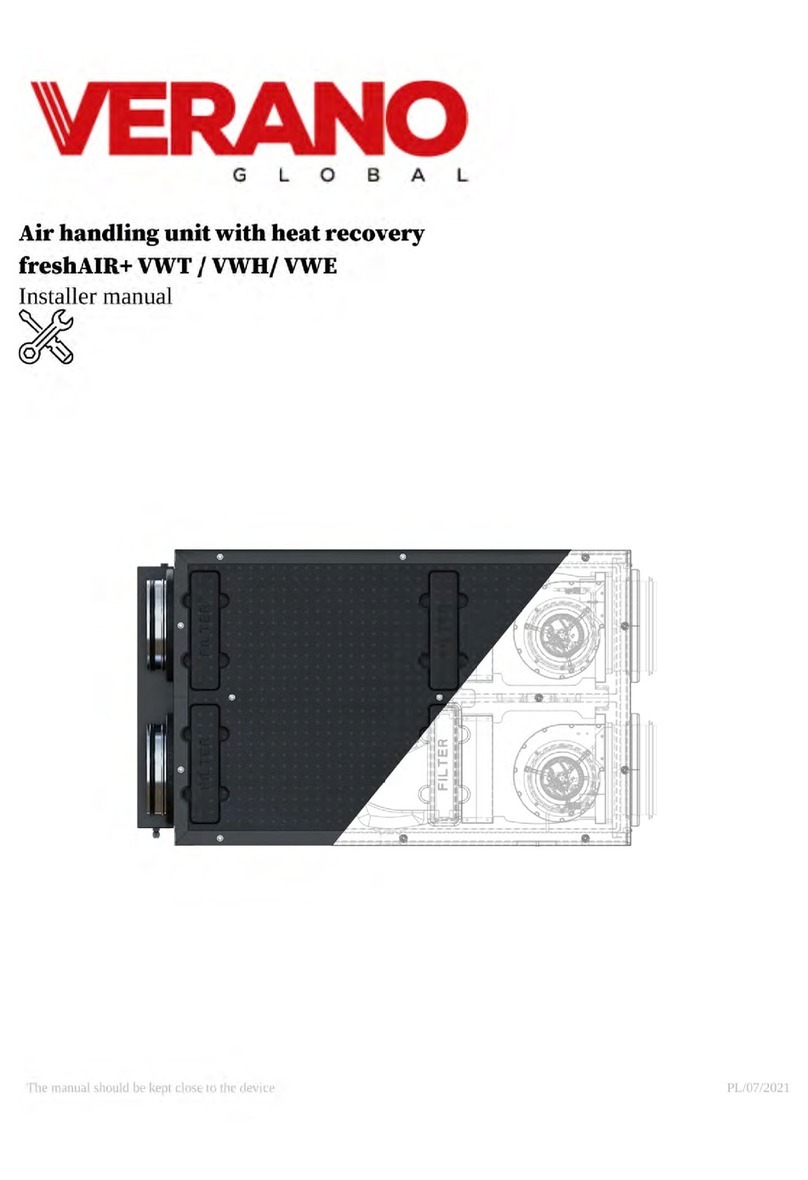
2. Safety
2.1. Responsibility
VS series recuperators are designed and manufactured for use in
balanced supply and exhaust ventilation systems. Using the devices
for other purposes is considered as use contrary to the intended use.
The appliance must not be connected to cooker hoods.
The manufacturer is not responsible for damage to the recuperator
or injuries caused by using it contrary to its intended use.
The air handling unit is intended solely for indoor operation. The
required value of the ambient temperature of the device is in the
range from + 5 ° C to + 40 ° C, relative humidity up to 70%.
2.2. Protection of the environment and
disposal
The high quality of products as well as the economy and ecology of
production, operation and disposal are for Verano Global Sp. z o. o.
equal goals. We strictly adhere to environmental standards and
regulations.
Taking care of the environment, we optimize production methods
by reducing the amount of waste and using materials that can be
completely recycled.
Factory packaging:
The packaging used for storage and delivery is suitable for later
use. The packaging, along with the purchased device, becomes the
property of the user. therefore, disposal is the responsibility of the
user or installer who is responsible for delivering and installing the
product.
Waste equipment:
After the service life of the product has expired, it should not be
disposed of with other municipal waste.
Pursuant to the regulations in force, improper disposal may lead to
the imposition of administrative penalties.
Out of concern for the natural environment, please recycle the
device responsibly at the end of its life. The device components
contain materials that must be sorted and recycled or disposed of.
Component access methods are described in this manual.
Take materials and components such as compressors, fans,
circulation pumps and printed circuit boards to a waste disposal
facility or dealer that provides disposal services.
2.3. Safety rules
Before starting any works related to the assembly or operation of
the recuperator, please read this manual. For the safety and comfort
of users, installation, assembly and service works should be carried
out by a qualified installer in accordance with applicable
regulations, accepted principles of engineering practice and this
manual.
The devices are intended for use in single-family houses, single
apartments and buildings of similar purpose. Alternative
applications of the device should be consulted with the
manufacturer before purchase.
The manufacturer is not liable for any damage resulting from
failure to comply with safety requirements and recommendations
or unauthorized modification of the device without the consent of
the manufacturer.
2.4. Safe use
Electrical connections, maintenance and servicing of the device
should be performed only by qualified installers in accordance with
the manufacturer's instructions and the applicable safety rules.
Before starting any service works, make sure that the heating
elements have cooled down and that the device has been
disconnected from the power supply and secured against accidental
start-up.
Due to the possibility of sharp and cutting edges, during
maintenance and service work be careful and use protective work
clothing and protection required by the provisions of Occupational
Health and Safety.
It is forbidden to:
connecting the device to a power supply other than that
indicated on the label,
operation of an unearthed device,
powering the device with an extension cord or a power
distributor,
powering the device by an electrical installation not prepared in
accordance with this manual,
starting the device before the end of the assembly work,
use of the device or installation connected with the device in an
aggressive or potentially explosive environment,
modify the device without the prior consent of the
manufacturer,
operation of the device by people who have not been trained or
read the manual, including children,
using the device for drying the construction site,
wkładania ciał obcych, w tym części ciała, przez króćce
przyłączeniowe do wnętrza urządzenia,
inserting foreign objects, including body parts, through the
connection stubs into the interior of the device.
The operation of the device should be stopped when:
there will be damage to the casing, including connection
nozzles,
there is any visible or audible damage to the device,
fluid appears on the electrical parts or connectors,
a foreign body gets into the installation.
Before removing the foreign body, as in the case of service work,
make sure that the heating elements have cooled down and that the
device has been disconnected from the power supply and secured
against accidental start-up. In the event of damage, immediately
shut down the installation and call the service in order to replace
the damaged elements.
ATTENTION! The device should be started only after connecting
the ventilation ducts. Starting the device without connecting the
channels creates a risk of injury from moving parts.
6




























